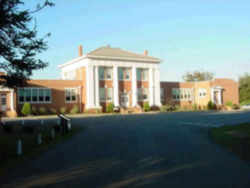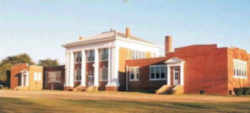
Georgia Symbols
Georgia State School
Plains High School

Adopted on April 22, 1997
The 1997 Georgia General Assembly passed a bill which named Plains High School the State School of Georgia. The legislation recognized educators Julia Coleman and Y.T. Sheffield for their outstanding leadership at the school. It also noted that President Carter and First Lady Rosalynn Smith Carter were graduates of Plains High School and that President Carter served on the Sumter County School board as his first political office.
Governor Zell Miller signed the bill into law on April 22, 1997. At this time, Plains High School was officially designated the State School of Georgia.
Plains High School opened in 1921, was racially integrated in 1966, and served students from Plains, Georgia until 1979.
The school was closed in 1979 as a result of the consolidation of county schools. Through a partnership between the community of Plains, the National
Park Service, and the United States Department of the Interior, the school was restored and reopened in 1996 as the main Visitors Center for the Jimmy
Carter National Historic Site.
Georgia State School: Plains High School
Restoration of Plains High School

Plains High School closed in 1979
and remained empty until legislation was passed in 1988 creating the Jimmy Carter National Historic Site in Plains, Georgia. Over the following seven
year period, the community of Plains partnered with the National Park Service (NPS) to restore the school and adapt it for reuse as the Jimmy Carter
National Historic Site Museum. The NPS reopened the visitor center portion of the Plains High School in July 1996 in anticipation of the Olympic crowds
expected in south Georgia. The west wing of the high school that houses the museum was completed by September and dedicated on October 1, on President
Carter's birthdate.
Efforts to preserve Plains High School began with legislation proposed to create the Jimmy Carter National Historic Site. Plans were discussed not
long after President Carter left office in 1981. Early discussions revolved around what resources should or should not be included at the historic
site. Early in the dialogue local residents felt the high school should be part of the historic site.
The community felt a close affinity for the high school and wanted to work with NPS. As legislation was proposed, NPS assessed the site, found that
the school suffered from serious structural problems, and concluded that it should not be included as part of the historic site. Although NPS wanted
to assist the community, it did not want to take on a resource that would drain critical federal funds. A compromise was reached when Congressman Richard
Ray, who authored the bill to create the Jimmy Carter National Historic Site, included language which limited federal contributions to no more than
60 percent of the cost for the restoration of Plains High School. This ensured the passage of the bill that created the Jimmy Carter National Historic
Site.
Upon passage of the bill, steps were taken to assess the structure and evaluate measures to prevent further deterioration. NPS's Division of Historic
Architecture developed a $5 million stabilization plan for the school, that was not well received when presented at a community meeting in June 1989.
Details of the plan included $2 million in funding from the city. Because this was an unrealistic figure for a city with very limited funds, NPS was
asked to re-examine their cost estimates.
An important outcome of the meeting was the formation of the Plains High School Liaison Committee (PHSLC) that worked with NPS on the restoration of
the school. The committee was comprised of four community members from Sumter County, including three who resided in Plains and at one time attended
Plains High School. It was decided by all parties that the Plains Historical Preservation Trust (PHPT) would be the best organization to administer
and manage fundraising efforts and control the dispersion of some of the funding. The PHPT was already a non-profit 501(c)(3) organization that could
legally raise and hold needed funds. The Committee's main responsibilities were to approve all aspects of the restoration/rehabilitation of the high
school; keep city staff, commissioners and other interested partners informed of the progress; navigate city politics; address problems and issues
affecting the work; and, meet with President and Mrs. Carter on a regular basis to keep them informed on progress.
Federal funds were made available for Plains High School in FY 1990 to remove asbestos and to replace the roof with a historically accurate standing
seam metal roof. Contracts were awarded for both projects and completed over a two year period.
As work began, attention turned to developing a restoration plan. The PHSLC met regularly and examined the feasibility of using prison labor. Although
an Executive Order prevented the use of prison labor on federal projects, the Jimmy Carter NHS authorization bill allowed for the use of donated labor
for work on Plains High School. An opinion from the Department of the Interior Solicitor's Office allowed for the use of prison labor on segments of
the project where the city was responsible for the work. The concept was presented to the community at a meeting in the spring of 1990 and favorably
received. The following summer, inmates from the Sumter County Correctional Institution began restoration work, replacing the termite infested roof
and the floor joists. Other inmate projects included plaster removal, and window and wall repairs. Recognizing the inmates had little or no experience
in plastering, NPS provided three plasterers to train inmates over a two-week period. The "on the job" training allowed inmates to apply
all the plaster in the school. The cost of the work, both cash and in-kind (inmate labor), was valued at approximately $ 56,000.
In 1991 NPS began to develop a General Management Plan. Many community residents were involved in the development of the plan which addressed how the
park and school could best be used. It was decided that the school would be best used as a visitor center and museum. Other plans were developed that
supported the school and included an interpretive prospectus, educational curriculum and a landscape plan.
Two grants totaling $20,000 were secured from the State of Georgia. These funds were used to purchase materials and pay for salaries of the guards.
The community raised additional funds by hosting special events. One particularly noteworthy event was Trains N Plains. Twelve Pullman cars were brought
to Plains in March 1991. The event provided exposure for the project. Three book signings of President Carter's book raised $20,000. The Plains Peanut
Harvest Picnic held in October 1993 on the grounds of the high school brought in an additional $15,000.
In 1992 President Carter requested a donation of plaster from US Gypsum for the plastering job project. The company responded favorably and donated
the materials. Following on this success, other companies were approached and contributed the following items:
American Standard - Plumbing Fixtures
Sloan Valve - Plumbing Fixtures
Sherwin Williams - Paint
US Gypsum - Plaster
Georgia Tile Co. - Floor Tile
Georgia Marble Co. - Bathroom Partitions
Trane Corporation - All Heating and Cooling Units
Shaw Industries - Carpet
Certianteed Insulation - Insulation
Andersen Windows - 101 Windows
Benjamin Moore - Paint
Installation and construction was completed by both the inmates and various paid contractors.
A contract was awarded for work on the roof and four trusses in the auditorium. It was an enormous job that involved removing the rotted trusses and
replacing them with new trusses. Another contract was awarded to finish the floors, restore the doors, and perform trim work.
The wooden backs and seats in the auditorium were ruined after years of exposure to leaks, causing the bent plywood to warp and break. A contractor
restored, painted and installed seats after they were removed from the building by inmates. Funding for this work was secured through the city with
a $50,000 grant from the Georgia General Assembly. Representative Bob Hanner and Senator George Hooks were instrumental in securing these funds.
An interpretive media plan was developed with exhibits and audiovisuals, including a 25-minute film on the life of Jimmy Carter and the history of
Plains. A direct mail initiative led by the Carter Center Development Office raised over $50,000. The film, produced by Ray DeTournay and narrated
by Charles Kuralt, was shot in the summer of 1995 and completed the following fall. Harman Industries contributed a video projector to show the film
in the school's historic auditorium.
The next step was the planning, design and fabrication of exhibits. The planning and design of the exhibits was contracted out for $100,000. Most of
the funds were made available after Trane Corporation donated the heating and cooling units, leaving $75,000 available for final design, fabrication
and installation. The Southeast Regional Office of the NPS provided $25,000 for initial conceptual planning and design. Plains Products, a local company
that manufactured components for the mobile home industry, donated labor to help park staff fabricate all the exhibit cabinets. Total exhibit work
was valued at over $1 million but completed for approximately $135,000, which included the Chief of Interpretation's salary for actual time spent on
project.
The school was identified as an educational resource for students. This was seen as a special opportunity where students could go to school in the
same place where a President and First Lady went to school. In 1991 an educational plan was developed and incorporated into the General Management
Plan. Next a curriculum was developed by the Chattahoochee Flint Regional Educational Service Agency. The community saw this as an opportunity to involve
the local school system in the project. Working with the Sumter County School Board, the plan was approved and funding was sought from the Georgia
Department of Education to fund a teacher position to run the program. In October 1995 the State Superintendent of Schools toured the building and
endorsed the project.
Eastern Parks Association purchased critical new furnishings for the book display area which offers visitors items for sale about the parks historic
themes.
In 1996, the National Park Foundation awarded the Plains High School project one of five Partnership Leadership Awards. The award was presented at
a ceremony at the Capitol on April 24, 1996.
Geographic area covered: The Jimmy Carter National Historic Site is located on 71 acres in Plains, Georgia. The Jimmy Carter National Historic Site
includes the boyhood home of Jimmy Carter, Plains High School, the Carter family compound where President and Mrs. Carter presently reside, Plains
Depot and a five-mile trail.







